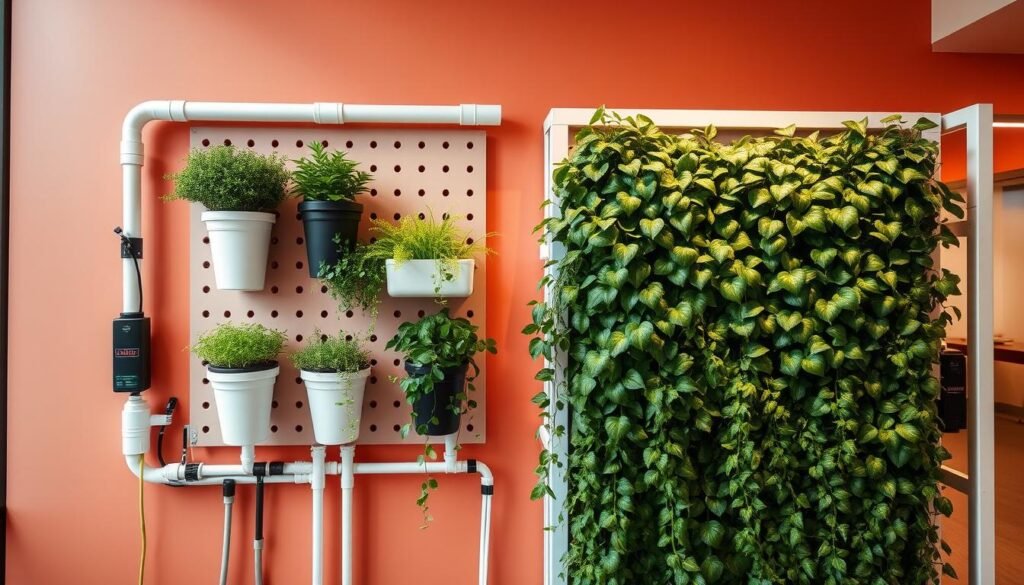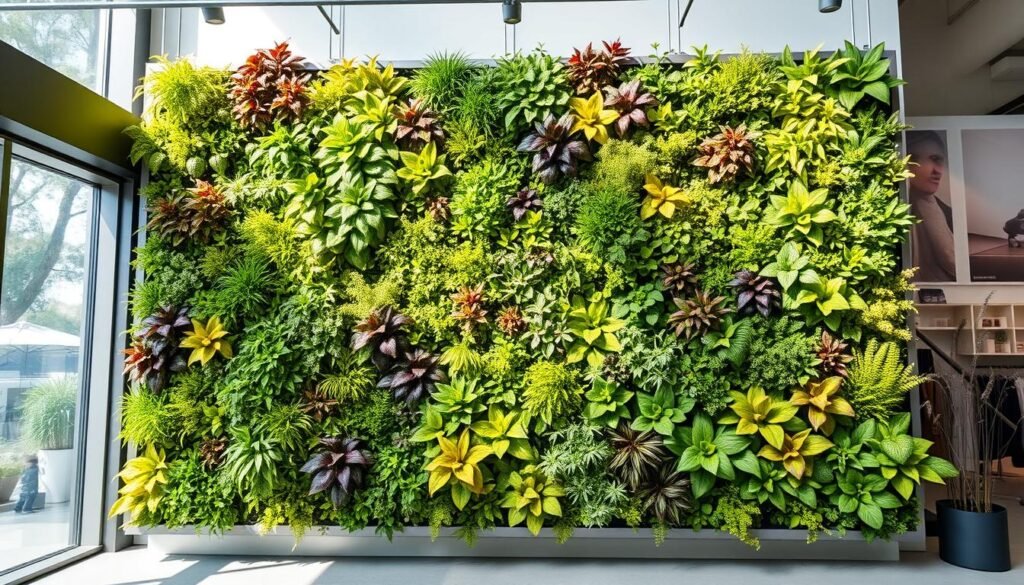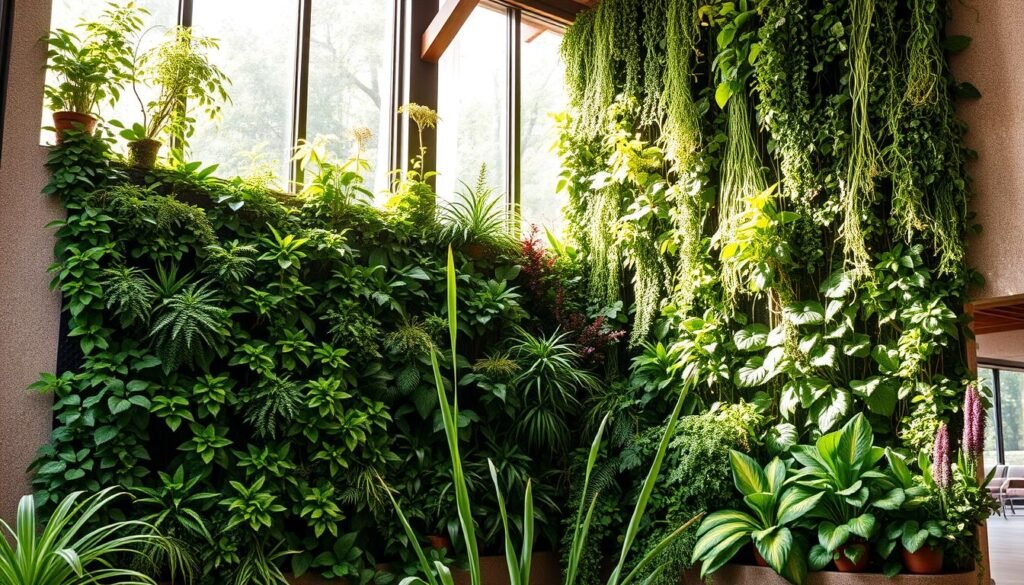I’ve always wanted to bring nature’s beauty into my home. Imagine a lush wall that not only looks amazing but also cleans the air and makes you feel better. This is what a living wall is all about, changing how we design and enjoy our indoor spaces.
In big cities, we often miss nature. Living walls bring nature right to our homes. These vertical gardens are not just pretty; they’re also a peaceful escape from city noise.
Key Takeaways
- Discover the transformative power of living walls in creating vibrant, nature-inspired indoor spaces.
- Understand the environmental, health, and aesthetic benefits of incorporating a vertical garden into your home or office.
- Gain insights into the essential components and considerations for successfully establishing your own indoor vertical garden.
- Explore a wide range of plant options and living wall systems to find the perfect fit for your unique space and design preferences.
- Learn valuable maintenance and care tips to ensure the long-term thriving of your living wall creation.

Understanding the Living Wall Concept and Benefits
Imagine a vibrant, verdant oasis in your indoor space. This design feature is called a green wall or plant wall. These vertical gardens can change any space, offering many benefits.
Environmental Advantages of Indoor Green Walls
Living walls are not just pretty; they also clean the air. They act as natural air purifiers, removing pollutants and adding oxygen. They also help control temperature and humidity, making the space more comfortable.
Health and Wellness Benefits
Adding a biophilic design like a living wall improves well-being. Studies show it reduces stress, boosts focus, and increases productivity. These living features create a calming and refreshing environment, improving health and wellness.
Aesthetic Value in Interior Design
Living walls also add beauty to any space. They can be stunning focal points, adding depth and natural beauty. Designers can choose plants and arrange them to create unforgettable living art.
“Living walls are not only beautiful, but they also offer a wealth of benefits that can transform the way we experience and interact with our indoor spaces.”
Essential Components of a Vertical Garden System
To make a thriving indoor living wall system or plant walls, you need to think about key parts. These parts work together to support a healthy garden. They include the structure, irrigation, and lighting, each playing a big role.
The base of a living wall system is the structure. It can be simple DIY frames or advanced panels for vertical gardening. The structure must be strong to hold the weight of the plants and any extra features.
The growing medium is also very important. It can be soil-based mixes or hydroponic substrates. These provide nutrients and keep moisture for the plants to grow well in a vertical setting.
- Irrigation system: A good watering system keeps the plants moist but not too wet or dry. It can be drip lines, misting systems, or recirculating pumps.
- Lighting: Plants need enough light to grow. The lighting must be right for the plants to photosynthesize and thrive.
When these parts work together, they make a beautiful, self-sustaining living wall system. This can turn any room into a lush, green oasis.
| Component | Purpose | Key Considerations |
|---|---|---|
| Structural Support | Provides a sturdy foundation for the plant walls | Weight capacity, durability, aesthetic appeal |
| Growing Medium | Supplies essential nutrients and moisture for the plants | Lightweight, water retention, air circulation |
| Irrigation System | Ensures consistent and controlled watering for the plants | Automated, efficient, prevents over- or under-watering |
| Lighting | Enables photosynthesis and plant growth | Intensity, spectrum, placement, natural or artificial |

Knowing and using these key components helps you build a thriving living wall system. It not only makes your indoor space look better but also offers many benefits for the environment and your health.
Selecting the Perfect Location for Your Plant Wall
Choosing the right spot for your indoor vertical garden is key. The perfect location can make your living wall a stunning centerpiece. It brings green architecture into your home and makes your space more beautiful. Let’s look at what to consider when picking the best spot for your plant wall.
Light Requirements and Exposure
Light is crucial for your indoor garden. Plants need enough light to grow well. Check the light in different parts of your home. Choose spots with good sunlight and indirect light. If needed, add grow lights for darker areas.
Wall Structure and Support Considerations
The wall’s strength is important too. Your living wall needs a strong base to stay safe. Check the wall’s material and how much it can hold. If unsure, get help from a pro to make sure it’s safe for your garden.
Temperature and Humidity Factors
The environment around your garden matters too. Plants like stable temperatures and humidity. Stay away from places with big temperature changes or humidity swings. Think about how your home’s climate control might affect your garden.
By looking at light, wall strength, and environment, you can find the best spot for your green masterpiece. It will be a beautiful addition to your home.
| Criteria | Optimal Conditions | Potential Challenges |
|---|---|---|
| Light Requirements | Direct and indirect sunlight, or supplemental grow lights | Low-light areas, inconsistent lighting patterns |
| Wall Structure | Sturdy, weight-bearing capacity, secure mounting options | Weak or unstable walls, limited attachment points |
| Temperature and Humidity | Moderate, stable conditions | Extreme temperature fluctuations, high or low humidity |
Best Plants for Indoor Living Wall Success
Choosing the right plants is key for a thriving vertical garden or plant wall indoors. These living wonders not only beautify your space but also offer health benefits. Let’s look at some top picks for an indoor vertical garden.
Light is a big factor when picking plants for your plant wall. Some plants love the dark, while others need lots of sunlight. For dimly lit spots, go for plants like pothos, snake plants, and ZZ plants. They do well in low light.
- Pothos: A hardy, trailing vine with lush, heart-shaped leaves that can tolerate a range of light conditions.
- Snake Plant: Also known as mother-in-law’s tongue, this upright succulent can survive in low-light and neglect.
- ZZ Plant: This resilient plant with shiny, waxy leaves can withstand low light and infrequent watering.
For sunnier spots, pick plants like philodendrons, English ivy, and ferns. They’ll grow well and make your vertical garden look lush.
- Philodendrons: Ranging from trailing varieties to upright species, philodendrons offer diverse foliage and growth habits.
- English Ivy: This classic climbing vine adds a touch of elegance and can be trained to cover a wall beautifully.
- Ferns: From delicate maidenhair ferns to robust Boston ferns, these plants bring a touch of nature indoors.
When picking plants for your plant wall, think about their water needs, growth patterns, and how they fit with your living wall system. With the right mix of tough and pretty plants, you can make a beautiful, eco-friendly vertical garden at home or work.

Installation Methods and Living Wall Systems
Creating a stunning modular green wall or a living wall system needs careful planning. These vertical garden solutions come in various options to meet your needs and tastes.
Modular System Options
Modular living wall systems are flexible and simple to install. They come as pre-fabricated panels that fit together. This makes it easy to adjust the size and shape to match your wall space. It’s a favorite for both homes and businesses.
Irrigation Solutions
An efficient irrigation system is key for your living wall’s health. Options like self-watering modules or drip systems make watering easy. These solutions cut down on maintenance and help your garden thrive.
Mounting and Support Techniques
Mounting and support are vital for your living wall’s stability. The right method depends on the wall and the weight of the plants. Planning and professional installation ensure your garden stays secure for years.
| Installation Consideration | Modular Green Wall | Living Wall System |
|---|---|---|
| Customization | High | Moderate |
| Ease of Installation | High | Moderate |
| Irrigation Complexity | Low | High |
| Maintenance Requirement | Low | High |
Choosing the right living wall system depends on several factors. Consider the size, customization, and maintenance needs. By evaluating these, you can create a beautiful and sustainable vertical garden that improves your indoor spaces.

Maintenance and Care Guidelines
To keep your living wall or plant wall thriving, you need to pay attention regularly. Here are the key steps to keep your indoor vertical garden healthy and green:
Watering and Fertilizing
- Water your living wall often, but make sure the soil isn’t too wet.
- Use a soft spray to avoid harming the plants.
- Fertilize every 2-4 weeks with a balanced fertilizer to feed your plants.
Pruning and Trimming
Pruning and trimming are crucial for your living wall’s look and health:
- Remove dead or damaged leaves to keep the wall looking good.
- Trim plants that are too big to keep the shape right.
- Get rid of weeds to stop them from taking over.
Pest and Disease Management
Watch your living wall for pests and diseases closely and fix problems fast:
- Check plants often for pests like aphids or mealybugs.
- Use a safe pest control if you find any pests.
- Deal with fungal or bacterial diseases quickly to stop them from spreading.
By sticking to these care tips, your indoor living wall or plant wall will stay vibrant and beautiful for a long time.

| Maintenance Task | Frequency |
|---|---|
| Watering | Regular, keeping soil moist |
| Fertilizing | Every 2-4 weeks |
| Pruning and Trimming | As needed to maintain shape and size |
| Pest and Disease Monitoring | Regular inspections |
Incorporating Biophilic Design Principles
Biophilic design connects people with nature, even in cities or indoors. Adding a living wall or vertical garden to your space can make it both beautiful and peaceful. This approach helps create a space that feels in harmony with nature.
Creating Natural Flow and Balance
Good biophilic design makes a space feel natural and balanced. Place your living wall to match the room’s layout and furniture. This way, the wall looks like it’s part of the space, making it calm and inviting.
Color Schemes and Plant Combinations
Choosing the right colors and plants is key for a living wall’s biophilic look. Use different greens, textures, and shapes to reflect nature’s variety. Add bright colors with flowers or leaves to make the wall lively and full of energy.
| Biophilic Design Principles | Key Strategies for Living Walls |
|---|---|
| Natural Shapes and Forms | Arrange plants in organic, asymmetrical patterns to create a natural aesthetic. |
| Natural Patterns and Processes | Incorporate diverse plant species with varying growth habits and life cycles. |
| Light and Space | Position the living wall to take advantage of natural light sources and create a sense of openness. |
By using biophilic design and green architecture, your living wall can become a stunning part of your space. It brings the outdoors inside, making your area more beautiful and natural.

Troubleshooting Common Living Wall Challenges
Keeping an indoor vertical garden healthy can be tricky. But, with the right steps, you can beat these challenges and keep your garden thriving. Uneven plant growth often comes from uneven light or water. Try moving your plants or tweaking your watering system to fix this.
Plant die-off is another common problem. It might be due to bad soil, pests, or too little humidity. Check your plants, make sure they’re getting the right food, and think about adding beneficial bugs. You might also need to adjust your humidifier.
Issues with your irrigation system, like leaks or clogs, need quick action. If you’re not sure what to do, get help from a pro. A broken irrigation system can harm your plants fast. With careful care and some troubleshooting, you can make your vertical garden look lush and green again.

Hello, I’m Jane, founder of Home Vibe Ideas. I’m here to inspire stylish Home Design, modern Smart Living, beautiful Outdoor Spaces, and creative DIY Projects to help you create a home that’s uniquely yours.
Disclosure: This post contains affiliate links. If you click on a link and make a purchase, we may earn a small commission at no additional cost to you. The content on this site was created with the help of AI technology.


